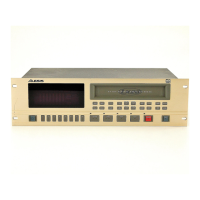Chapter 2 - LX20 Essentials
ADAT LX20 Reference Manual 23
DIFFERENCES COMPARED TO ANALOG RECORDING
Recording on the LX20 is very similar to most multitrack tape machines. With a
formatted tape loaded, put one or more tracks into record-ready, adjust record levels
on your mixer, set the input monitor mode, locate to where you want to begin
recording, and engage record. However, there are two main differences, described
next.
“THREADED” VS. “UNTHREADED” TAPE
The LX20 uses a rotating head drum which records and plays back digital audio
signals from tape. Even when the tape is stopped, it remains “threaded” or engaged
against the spinning head drum for a period of time. This allows for going into play
or record faster, as well as provides “cue” and “review” functions that let you
monitor the tape audio at faster-than-normal play speeds. When threaded and
stopped, the STOP button LED is lit steadily.
When the tape is unthreaded (the STOP LED flashes), it takes a little bit of time
for the tape to wrap around the head drum before it can go into play or record. Cue
and review functions are not possible while the tape is unthreaded.
When the tape is threaded and stopped, you can manually unthread it by pressing
the STOP button. The STOP LED will flash, indicating the tape is now unthreaded.
Pressing either PLAY or STOP, or PLAY and RECORD to engage recording, re-
threads the tape.
If the tape is threaded, and no transport activity (play, record, rewind, etc.) occurs
for 4 minutes, the tape will automatically unthread itself to minimize tape wear.
DIGITAL DISTORTION AND HEADROOM
With analog tape, it is common to record “in the red” as distortion increases slowly
with increasing level. Small amounts of analog distortion may not only be difficult
to hear, but may even be considered desirable. Another reason for recording at
elevated levels is the limited dynamic range of analog tape — hitting it with as
much level as possible minimizes noise.
With digital recording, signals remain undistorted up to the 0 (clipping) point, at
which point distortion increases dramatically. Alesis recommends never exceeding
0, and recording at an average level of around -15 to -10 dB. With the exceptional
dynamic range made possible with 20-bit recording, there is no need to “slam”
levels. Giving your signals a little bit of headroom provides a margin of safety
against distortion.

